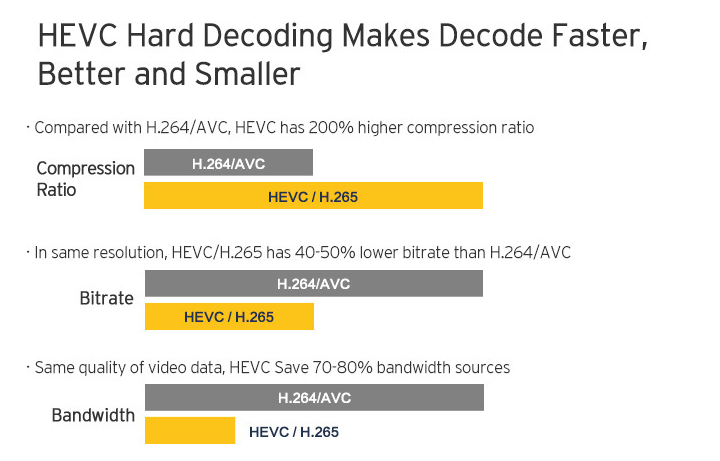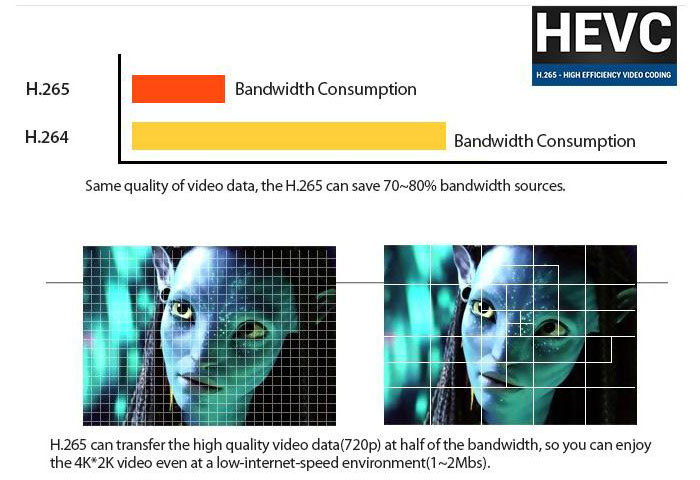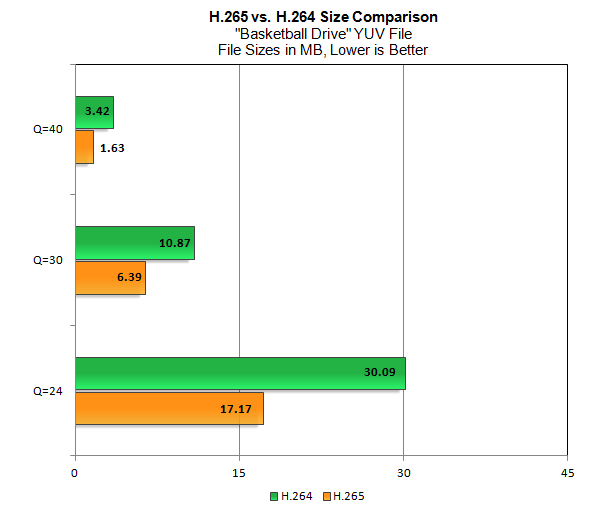H.265, also known as High Efficiency Video Coding (HEVC), is the successor standard to H.264, and
has generated huge optimism given Industry's struggle with shortage of bandwidth, spectrum, storage
and imminent need to take growing HD content for multi platform delivery.Compared with the existing
popular video coding standard H. 264, H.265 keeps some of the original technologies, and adopts
the advanced techniques to improve the bit-stream, promote the coding quality, and create a better
relationship between time delay and algorithm complexity, to achieve best optimizations as far as
possible.
Today, we will make detailed H264 vs H265 (as well as HEVC vs H264) comparisons on them.
1, Differences between H.265/HEVC and H.264:
Some of the key differences between H.265 (HEVC) and H.264 (MPEG 4 AVC) are listed below
| Category | H.264 | H.265 |
| Names |
MPEG 4 Part 10 AVC (Introduced in 2004) |
MPEG-H, HEVC, Part 2 (Approved in Jan 2013 ) |
| Industry adoption |
Dominant and accepted video codec forTerrestrial,Cable, Satellite and IPTV broadcast. (ATSC/DVB/ISDB) Widely used across Blu Ray, security systems, vide conferencing, mobile video, media players, video chat etc. |
Implementation demonstration across NAB, IBC and other events starting 2012 from companies e.g. ATEME, Broadcom, Thomson, Harmonic (Cisco), Ericsson, Qualcomm etc. Increased R&D across Encoder/Decoder /CE,vendors for software and hardware based solutions |
| Key Improvement |
40-50% bit rate reduction compared to MPEG-2 |
40-50% the bit rate reduction at the same visual quality compared to H.264 |
|
Led the growth of HD content delivery for Broadcast and Online |
Potential to realize UHD, 2K, 4K for Broadcast and Online (OTT) |
|
| Progression | Successor to MPEG-2 Part | Successor to MPEG 4 AVC, H.264 |
| Compression Model |
Hybrid spatial-temporal prediction model |
Enhanced Hybrid spatial-temporal prediction model |
|
Flexible partition of Macro Block (MB) , sub MB for motion estimation |
Flexible partitioning, introduces Coding Tree Units (Coding, Prediction and Transform Units -CU, PU, TU) |
|
|
Intra Prediction (extrapolate already decoded neighboring pixels for prediction) |
- 35 directional modes for intra prediction |
|
| - Introduced multi-view extension |
- Superior parallel processing architecture, |
|
|
enhancements in multi-view coding extension |
||
|
9 directional modes for intra prediction |
CTU supporting larger block structure(64x64) with more variable sub partition structures |
|
|
Macro Blocks structure with maximum size of 16x16 Entropy coding is CABAC and CAVLC |
Entropy coding is only CABAC | |
| Specification | Support Up to 4K (4,096×2,304) | Up to 8K UHDTV (8192×4320) |
|
Supports up to 59.94 fps 21 profiles ; 17 levels |
Supports up to 300 fps
3 approved profiles, draft for additional 5 ; 13 levels |
|
| Drawbacks |
Unrealistic for UHD content delivery due to high bit rate requirements.Frame rate support restricted to 59.94 |
Computationally expensive (~ 300 % + ) due to larger prediction units and expensive Motion.Estimation (Intra prediction with more nodes, asymmetric partitions in Inter Prediction). |
2, H.265 vs H.264 Compression Ratio & Bandwidth Utilization
H.265 has better compression performance and lower bandwidth utilization ratio.
For video services, the ultimate goal of compressing a movie is to reduce the size of the movie file, so that it
can take up less storage space, as well as reduce the network bandwidth consumption in transmission.
Compared with H. 264, the greatest strength of H. 265 is that it has a higher H.265 compression ratio, which can
be just discerned from its name, which is also called HEVC (High Efficiency Video Coding), and the primary use is
to further reduce the design flow rate, in order to lower the cost of storage and transmission.
In other words, at the same quality of coding, H.265 video can save around 50% of the bit rate, and the coding
efficiency can be doubled than H. 264, as H.265 provides more different tools to reduce the bit rate. For example,
in H. 264, each macroblock is fixed to the size of 16 x16 pixels, but the coding unit of H.265 can be chosen from
a minimum of 8 x 8 to the maximum of 64 x 64.


0n the left hand side as the illustration shows above is using traditional H.264 standard, and each macro block
is fixed; In H. 264 coding technology, the giant sections of data is completely independent to each other, so coding
distortion situations are likely to happen in border areas of the giant block.
It is H. 265 standard on the right, the size of code unit is determined by the regional information. From the image
contrast, we can see the video quality enhancement and the more delicate character’s skin under H. 265 are much
better than H. 264.
3. H.264 vs H.265 File Size

©2003-2025 SDMC Technology Co., Ltd